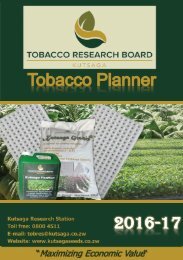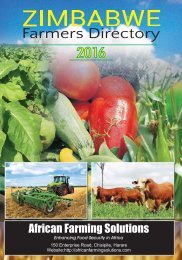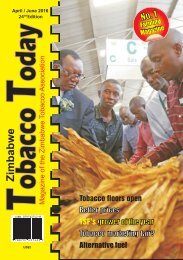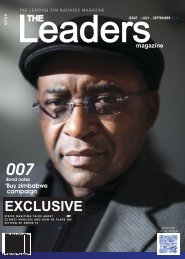livestock
Create successful ePaper yourself
Turn your PDF publications into a flip-book with our unique Google optimized e-Paper software.
A Magazine for Livestock and Meat Advisory Council & its allied associations<br />
G<br />
rowing<br />
GROWING STOCKPILES OF HIDES<br />
stockpiles of<br />
hides at<br />
Zimbabwe's - Rethinking the export of hides and skins<br />
abattoirs highlight the<br />
deepening crisis in the<br />
hide-to-leather value chain.<br />
This has been precipitated<br />
by concurrent crashes in the<br />
local and international hide<br />
market and the introduction<br />
of an export surtax to<br />
protect home industry that<br />
translates into almost 90%<br />
of the current international<br />
market price, making it<br />
sub-economic to export<br />
hides.<br />
In the current economic<br />
slump, the local tanning<br />
industry is not able to take<br />
up its quota of hides for<br />
value addition under the Shutterstock<br />
Zimbabwe Leather Sector<br />
Strategy (2012 –2017). Far also calling for an increase<br />
Hides outside a shoe store<br />
it is sub-economic for continue to decline, with<br />
from stepping up beneficia- in the export quota from abattoirs to export hides reduced demand for hides<br />
tion to the targeted 75% of 25% to 40% with no from Zimbabwe. and a decrease in local<br />
raw hides and skins, local restrictions on exports when Global market prices for market prices. It is feared<br />
tanneries are only able to the local market is unable both raw and wet blue that mounting stocks of<br />
absorb a small percentage to take up its quota. Some hides have plummeted to hides at abattoirs will lead<br />
of flared hides and are 60% of Zimbabwe's raw their lowest level for several to further hide spoilage.<br />
offering prices ranging hides meet quality years. The crash in the local Money realised from<br />
from 12% to 50% of specifications for the market prices is even more hides could be ploughed<br />
international market prices, international wet blue hide drastic, with prices falling back into a Leather<br />
which have also plummeted<br />
Development Plan<br />
in the international hide The competitiveness of the tanning industry to build the capacity of<br />
market crash.<br />
must be strengthened, so it can play its role in tanneries to operate viably,<br />
“The Abbatoirs<br />
strengthening the whole<br />
Association of Zimbabwe value addition, outlined in the Zimbabwe leather value chain<br />
(AAZ) fully supports local<br />
Leather Sector Strategy<br />
AAZ is also proposing to<br />
value addition and<br />
establish a Leather Industry<br />
recognises that the local market. by as much as 50% in Fund from a fair hide levy<br />
tanning industry must have In October an export 2015. that will be ploughed back<br />
first priority on hides,” surtax of 15% or $0.75/kg The competitiveness of into developing the leather<br />
emphasises AAZ chairman, — whichever is the tanning industry must industry to strengthen<br />
Godrey Chanetsa. greater—was imposed on be strengthened, so it can tannery competitiveness. It<br />
“Beneficiation is important the export of raw hides play its role in value would be modelled on the<br />
to grow the Zimbabwean under the 2015 Mid Term addition, outlined in the Dairy Revitalization Fund to<br />
economy. Fiscal Policy Review Zimbabwe Leather Sector grow the home dairy<br />
“But where good quality Statement. At the same Strategy industry, which is funded<br />
hides are going to waste time, export tax on hides “In the whole equation, from the 10 cents a litre<br />
because the local market is was extended to the 25% there is a need to restore levy on all UHT milk<br />
not able to use its quota, export quota not reserved competitiveness in the local imported into Zimbabwe.<br />
we feel there should be for local tanners in the tanning industry,” explains Revenue generated from<br />
flexibility to allow us to Zimbabwe Leather Sector Chanetsa. “Local tanners tax on raw hide exports is<br />
move these stockpiles of Strategy (2012–2017). must be competitive; not not being channelled into<br />
hides and sell them on the In the global hide market under-price hides in order building the leather<br />
international market,” says slump, this effectively to survive at the expense of industry.<br />
Chanetsa. means that there is a tax on abattoirs and farmers who AAZ members account<br />
AAZ proposes reducing all hide exports, which produce the raw materials for some 70% of formal<br />
the export tax to a equates to 88% of the for this industry.” sector cattle slaughters and<br />
reasonable percentage of international market prices. High processing costs are the largest producers of<br />
the export parity price. It is At $0.05—0.10 cents a kg, have seen tannery profits hides in Zimbabwe.<br />
14<br />
Livestock Today April-June 2016







